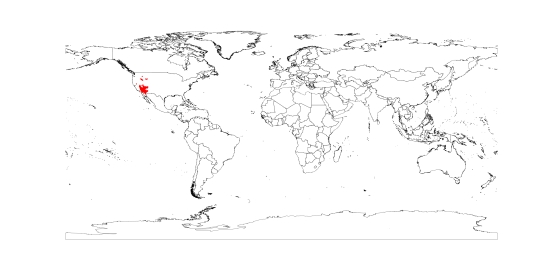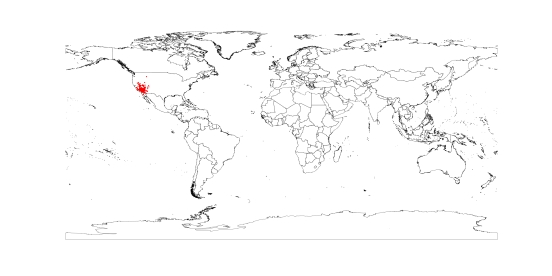Langloisia and Loeseliastrum are sister genera native to southwestern North America. The clade is comprised of five species. Specific assignment within each genus has had a tortuous taxonomic history. Timbrook (1978, 1986) cited morphological, palynological, chromosomal, and phytochemical evidence to support the segregation of the two genera. However, Lo. depressum was not treated by Timbrook as it remained in Ipomopsis at that time. Molecular evidence clearly places Lo. depressum in this clade and as a result the logic behind Timbrook’s circumscription no longer holds true. Molecular evidence seems to suggest that these genera are distinct, however (see below). However, due to morphological and phylogenetic similarities, I treat both genera on the same page for the time being.
Langloisia was defined by Timbrook based on the following characters:
- clustered bristles on upper leaves
- actinomorphic corollas
- erect stamens of equal length
- white to blue pollen
- branched trichomes
- capsule valves three times as long as wide and convex across the back
By contrast, Loeseliastrum was defined as having:
- single bristles on upper leaves
- zygomorphic corollas
- declined stamens of unequal length
- yellow pollen
- unbranched trichomes
- capsule valves two times as long as wide and concave across the back
Loeseliastrum depressum possesses no lateral bristles, zygomorphic corollas, erect stamens of unequal length, and white to blue pollen and is therefore morphologically intermediate between the two genera sensu Timbrook. However, Timbrook placed most emphasis on the clustering of bristles, stating that the: “infallible character of leaf bristles allows ready separation of Langloisia and Loeseliastrum” (Timbrook 1977 p. 31) yet this character is somewhat variable as bristles (when clustered) may be single or clustered on the same leaf. Furthermore, Timbrook (1978) demonstrated crossability (however slight) between his two genera which sometimes resulted in more seed set per capsule than crosses within genera!
Phylogeny
Langloisia and Loeseliastrum form a clade with Microgilia and Eriastrum, and are sister to the latter genus. While Johnson et al. (2008) recovered Langloisia and Loeseliastrum as monophyletic, however the monophyly of Loeseliastrum was uncertain. Using more DNA data, Rose & Sytsma (2021) recovered much stronger support for the monophyly of Loeseliastrum, though the genera are poorly defined morphologically, as discussed above. Given the distribution of traits in related genera, the decumbent anthers and yellow pollen indicative of Loeseliastrum appears to be a derived condition in this clade.

Biogeography
Both genera (with one exception) are restricted to desert regions of southwestern North America (United States as well as Baja California and Sonora, Mexico). Langloisia setosissima subsp. punctata occurs in both southern California and Nevada and reappears as a disjunct in southern Idaho and eastern Oregon in the Snake and Salmon River valleys (Timbrook 1978, 1986).
Taxonomy
- Langloisia setosissima (Torr. & A. Gray)
- La. setosissima (Torr. & A. Gray) subsp. punctata (Coville) Timbrook
- La. setosissima (Torr. & A. Gray) subsp. setosissima
- Loeseliastrum depressum (M.E. Jones) J.M. Porter & L.A. Johnson
- Loeseliastrum franciscanum R. Crawford
- Loeseliastrum matthewsii (A. Gray) Timbrook
- Loeseliastrum schottii (Torr.) Timbrook
Timbrook (1978) rejected recognizing La. punctata as a distinct species based on supposed overlap in morphological features. However, the corolla coloration is distinctly different in the two (purple with maroon streaks in La. setosissmia compared to white with maroon dots and yellow nectar guides in La. punctata) suggesting reproductive isolation. The disjunct populations of La. setosissima subsp. punctata in southern Idaho and eastern Oregon posses several morphological differences and might be best treated a new taxon. This warrants further study.
KEY TO LANGLOISIA AND LOESELIASTRUM (modified from Timbrook [1978]; Crawford & Ayers [2017])
1. Corolla actinomorphic; bristles of the upper cauline leaves clustered (La. setosissima).
2. Corolla lobes 0.3-0.5 X length of the tube; filaments > 3 mm long…La. s. setosissima
2′. Corolla lobes 0.5-1 X length of the tube; filaments ca. 5 mm long…La. s. punctata
1′. Corolla zygomorphic; bristles of the upper cauline leaves solitary or none.
3. Corolla 4-8 mm long; hyaline membrane of calyx wider than green lobes.
4. Leaves entire to slightly bristly with a long apical bristle; corolla only slightly zygomorphic; stamens included…Lo. depressum
4′. Leaves with conspicuous lateral bristles; corolla strongly zygomorphic; stamens exserted…Lo. franciscanum
3′. Corolla 8-21 mm long; hyaline membrane of calyx narrower than green lobes.
5. Corolla 11-21 mm long, upper lip 0.75-1.5 X length of the tube; longest filaments equal to upper lip of corolla, calyx 0.5-0.75 length of the corolla tube…Lo. matthewsii
5′. Corolla 8-15 mm long, upper lip 0.5-0.75 X length of tube; longest filaments shorter than the upper lip of corolla; calyx 0.75-1 X length of corolla tube…Lo. schottii
References
Crawford, R., & Ayers, T. (2017). A new species of Loeseliastrum (Polemoniaceae) from Northern Arizona. Madroño, 64(1), 51-58.
Johnson, L.A., Chan, L.M., Weese, T.L., Busby, L.D. and McMurry, S., 2008. Nuclear and cpDNA sequences combined provide strong inference of higher phylogenetic relationships in the phlox family (Polemoniaceae). Molecular Phylogenetics and Evolution, 48(3), 997-1012.
Rose, J. P., & Sytsma, K. J. (2021). Complex interactions underlie the correlated evolution of floral traits and their association with pollinators in a clade with diverse pollination systems. Evolution, 75(6), 1431-1449.
Timbrook, S. L. (1978). Biosystematic studies of Langloisia and Loeseliastrum. Ph.D. Thesis, University of California, Santa Barbara.
Timbrook, S. (1986). Segregation of Loeseliastrum from Langloisia (Polemoniaceae). Madroño, 33(3) 157-174.




